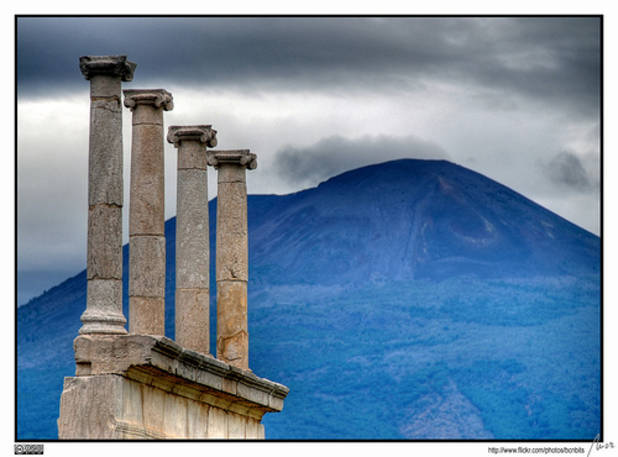


Owning a beautiful home is pointless if you haven’t got the means or will to maintain it. What you’re left with is weeds and decay—the sort of situation Dickens imagined for his deranged Ms. Havisham. And it must truly be madness that Italy’s regional administrations are suffering from for their own cherished properties are in a woeful state of disrepair. Both Pompeii—the impressively preserved 2,000-year-old city south of Naples—and Sicily’s Valley of the Temples, have been singled out as victims of looting, neglect and mismanagement.
Pompeii is a UNESCO World Heritage site, but thus far that coveted title hasn’t served towards protecting it. As the Roman city that was found virtually intact, buried under ash from the eruption of nearby Mount Vesuvius in 79 A.D., it is a rare find that warrants careful safeguarding. But now its iconic frescoes (many of them in a bold, blood red, hence the term “Pompeian red”), found within the villas of what was once the city’s wealthiest inhabitants, and that represent unique examples of Ancient Roman art, are crumbling away at an estimated 150 square meters a year. Annually some 3,000 pieces of stone ruin at the site end up disintegrating. As if this futile evisceration weren’t sufficiently demoralizing, as a tourist destination Pompeii is ill-equipped. There are only three bathrooms in its 440, 000 square meter area and many of the villas, by far the city’s most spectacular offerings, have been sealed off for restoration—some of them for as long as 20 years. This writer has visited Pompeii more than once, and can personally attest that it is nothing short of a miracle if you find that the villa of your choice is open. Still one of the most visited places in Italy, Pompeii generates approximately 20 million Euros a year (2007 figure), so the nagging question is, where does it all go? Seeing as the site itself doesn’t benefit from any maintenance work, and that the area surrounding Pompeii, where Campania natives hawk trinkets, is nothing more than a depressed, arid wasteland, it is safe to say that revenues aren’t being properly invested.
Negative media reports on the state of Pompeii have finally spurred the Italian cabinet to action. They have called a state of emergency, with Culture Minister Sandro Bondi saying he will appoint a special commissioner to oversee the situation. Claudio Velardi, Campania’s tourism chief, welcomed the move. His proposal to redress Pompeii’s problems, however, included limiting the number of tourists per year and allowing entrepreneurs to hold events among the ruins—a widely unpopular decision. Is this the best politicians can do, disburden themselves of their clearly-appointed tasks by inviting the private sector to supplement the money they should have been properly administering in the first place?
Apparently, yes. It is also the case for the Valley of the Temples and a handful of other ancient landmarks in Sicily. The Valley is another one of Italy’s prized treasures, a swath of elevated land on which seven Greek temples sit. The Doric-style wonders, dating back to the 6th and 5th centuries B.C., are some of the best preserved temples outside of Greece and are also listed as a World Heritage site. Sicily, referred to sometimes as “Magna Grecia” , contains several terrifically preserved Greek monuments.
Antonello Antinoro, Sicily’s regional counselor for culture, has recommended entrusting the Valley to a private tour operator for a period of 30 years, “in order to make it more profitable.” Filippo Panarello, deputy chairman of Sicily’s culture committee, shot back that it would be a “paradox if the region with the highest number of public employees decided to entrust the management of public assets to private parties.” Indeed the Valley of the Temples and comparable Sicilian attractions are part of the region’s artistic and historical patrimony, and as such, should remain in public hands—albeit with a serious re-evaluation of their management.
A first step could be to expand the days in which the Valley is open to tourists. Eager travelers to Sicily often find themselves locked out of their guide book’s “must see!” destinations because they happened to have showed up on a Sunday or a holiday (usually an arbitrarily selected weekday). Last year the site suffered embarrassment in the press when its guards, highly bureaucratic appointees, turned down a large group of school children because their free passes didn’t extend to non-E.U. citizens.
These are issues that can’t be pawned off to the first businessman who decides he wants to host his very own authentic toga party. Local and state politicians have to embrace the privilege they were given and act as stewards of their country’s rare artistic fortunes.
Source URL: http://test.iitaly.org/magazine/focus/life-people/article/finance-and-ruins-italys-treasured-sites-in-peril
Links
[1] http://test.iitaly.org/files/411648832ee71cf25ef1215606644jpg